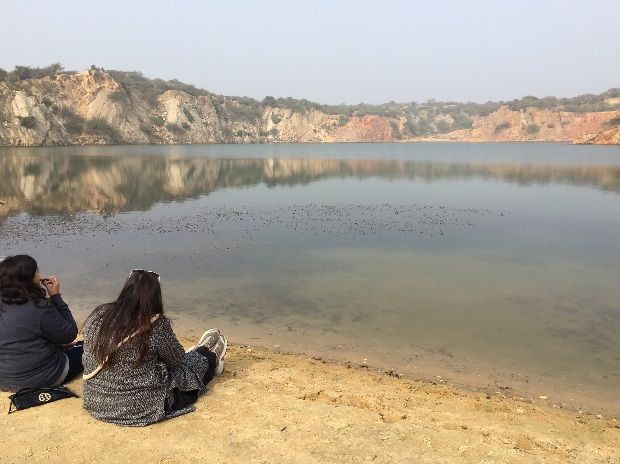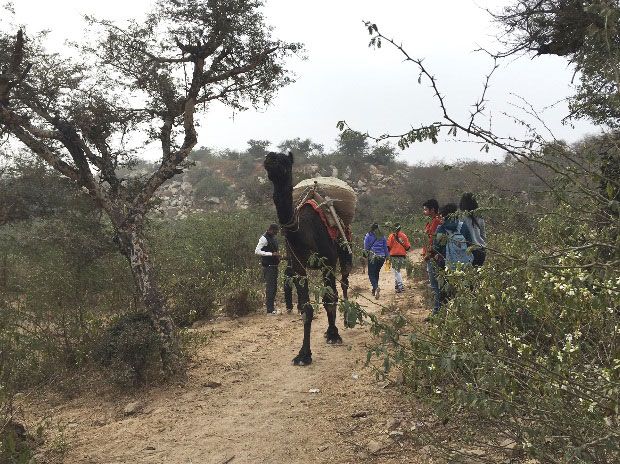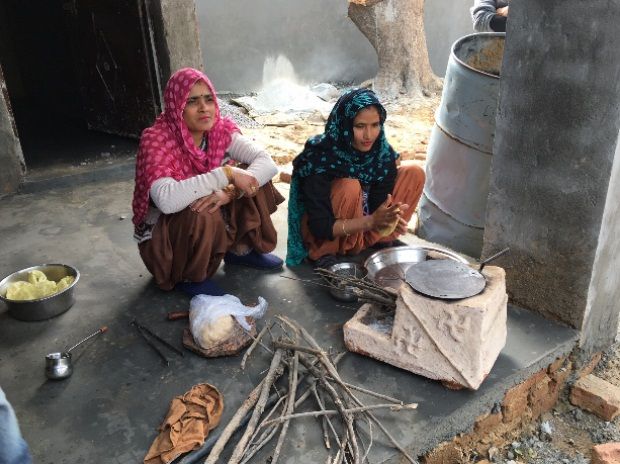Geetanjali Krishna takes you on a trail through the hidden lakes in the urban sprawl of the National Capital Region.

It's a crisp Sunday morning.
We're standing opposite a new real estate development that promises life in the lap of nature, except that there's little nature on the dusty road to Faridabad.
But that's the thing about Delhi and areas around it -- their urban sprawl somehow hides many pockets of nature that enthrall and delight.
So, suddenly, when the unplanned human spread gives way to a dirt track, leading to the classic Aravali terrain -- hilly and overrun with thorny bushes and copses of khejri (prosopis cineraria) and khair (acacia catechu) trees -- I'm not surprised.
I've always loved the Aravalis. The oldest mountain ranges in the world, their arid, thorny vegetation and gnarled rocks have a unique charm.
Our biggish group of 30 lake seekers walks single file into the forest.
A lone peacock calls and the jungle closes in on us.
Ahead, we run into a group of cyclists from Gurgaon. It's good we are here in such a large group, they say.
It's easy to get lost here and wander into the prohibited core areas of Asola forest.
As mobile phone networks are patchy, my trusty Google Maps would be of little use, I muse, resolving to stay close to our local guide, Mam Chand, alias Bholi ji, and Ramit Mitra of Delhi By Foot, organisers of this walk.
The hill dips dramatically into a precipice. Far beneath us, past layers of scarred sedimentary rock, lies a beautiful body of blue water.

Bholi ji tells us this is one of many lakes formed in this area due to reckless and unmanaged mining of sandstone, lime and Badarpur sand. "Till a couple of decades ago, these lakes were huge open pit mines. Extensive dynamiting turned these hills into troughs," he says.
Groundwater seeped in, rainwater collected, and these picturesque lakes came into being.
Apparently, it wasn't until the early 1990s that mining was banned, and this highly eco-sensitive area -- the semi-arid forest of the northernmost extension of the Aravali hills on the southern boundary of Delhi -- was notified as a wildlife sanctuary.
Ahead on the path, we see a camel laden with sand and stone.
"Villagers still unofficially carry away building material from here," says Bholi ji.
There aren't any viable paths down and the layers of stone laid bare by mining seem too brittle to risk stepping on.
So we walk on, content to watch the lake from above.
Ahead, we come to a sandy promontory that offers great views of the forest.
Our feet sink into the soft sand as we move up, again in single file.
I marvel at the changing landscape, which suddenly seems more arid than it did a little while ago.
Black kites lazily soar on air currents and, as I watch them, the sun finally takes the sting out of the morning chill.
I have an urge to sit a while. But it's time to go, for there are more lakes waiting to be discovered.
We clamber over rocks, as the colour of the mud underfoot changes from sandy yellow to gravel red, glinting with the shimmer of mica.
One can really see the mineral diversity of the Aravalis here, I muse, as we look at layers of rock exposed by mining. "Are we skirting the same lake or is this another one?" I ask Bholi ji as we come across another hidden body of water.
It's another one, I learn.
Apparently, these lakes are uncharted.
No one knows how deep they are, and many an unwary picnicker has drowned in them.
Bholi ji tells me that there are large fish in these lakes.
Locals feed them but don't eat them, and he doesn't know why. They don't even use the lake water for everyday chores.
Could it be that the dynamite has poisoned the soil and water here, making them unfit for consumption, I wonder.
If so, it is ironic that this very poison is ensuring the lakes stay as clean as they are today.

Our last stop is the Bhardwaj lake in Asola, the only one of these lakes that has a name.
Is the lake named after the great sage of yore, I ask?
Sadly, it isn't.
It is, I'm told, named after a mining contractor.
We sit on its sandy banks, sharing snacks and taking photographs.
Later, as we enjoy a rustic picnic of makke ki roti, saag, gur and lassi, village women who are feeding us ask how the trek was.
Our replies are way more enthusiastic than their expressions. Do they visit the lakes sometimes, I ask? "Hardly ever," says one. "They are of little use to us."
And so, we return to civilisation, with little more than sand in our shoes and memories of some of the prettiest but cruelest reminders of the price that earth pays for human consumption.










